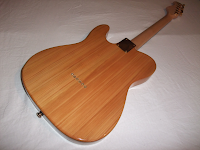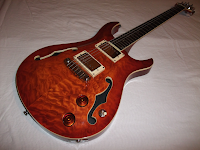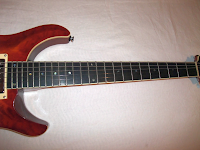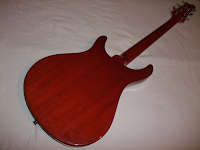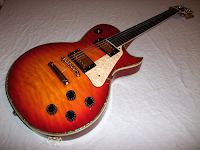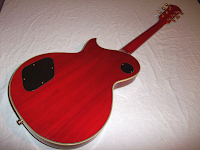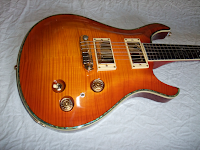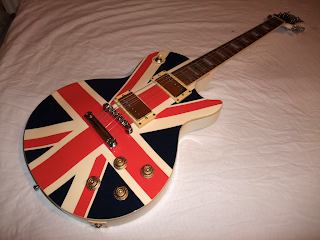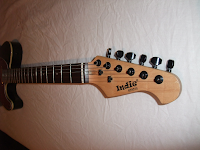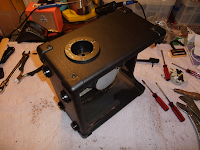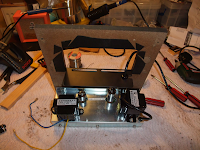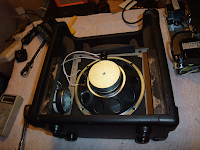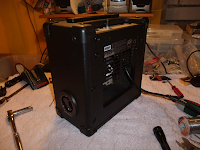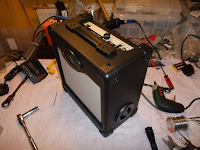
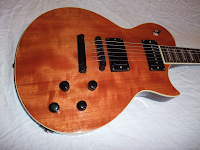
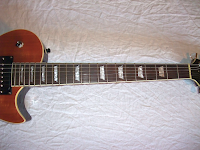




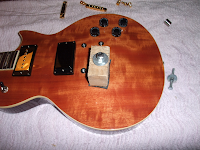
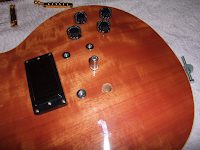
If I have a 'go to guitar' then this is it. Well unless I'm playing at being a thrash metal shredder when it's one of my EC29s. That is why this guitar is pictured at the top of my blog.
This was another secondhand purchase as a job lot with an Indie IT-30 amp. These had not been brilliantly cared for. The guitar had one odd machine head where the button from the original had been smashed off and one of the studs for the tailpiece had been pushed into the body damaging the lacquer on the top around it. It took me a while to notice the second fault and I suspect the seller didn't even know it had happened. There was a matching ding in the head of the bridge stud so it'd probably had quite a smack. Other than these two faults it had very minor play wear, almost like these had been done in a single incident perhaps during shipping or storage. The seller had recently moved house so maybe it was the removal men.
The machine head was easily solved as I discovered the generic 'tulip' machine heads sold by
CH guitars on eBay were in fact identical to the ones used by Indie. Lots of the Korean guitar hardware sold by them (and
AxesRUs) is identical to that used on Indie guitars, which was very useful to find out for my various modding projects.
The spec. is the usual good Indie stuff...
Body: Solid mahogany
Body Top: None
Body Binding: Single cream
Neck: Hard maple
Neck Binding: Single cream
Neck Construction: Set neck
Fingerboard: Rosewood
Fingerboard Inlay: Crown inlay
Headstock Binding: Single cream
Head Machine: Indie diecast tuner
Top Nut: Graphite
Bridge: Tune-o-matic with stop tail
Hardware: Chrome
Pickups: 2 humbucker/Indie standard
Electrics: 2 volume, 2 tone, 3-way toggle
Truss Rod: 2-way dual action
Scale Length/Frets: 628mm(24.7")/22 frets
Finish: Natural
...with this being a slightly modern take on the classic single cutaway Les Paul shape. It has Indies tidier later headstock design and their very nicely redesigned heel joint and cutaway. The curve of the upper bout follows through the heel and down to the cutaway. This makes for very good upper fret access and a slightly more distinctive design.
The simple mahogany body with natural finish looks great. In some ways I prefer this understated look to the more bling models. Nevertheless I thought the chrome hardware and pickups looked a bit anemic set against this and decided to undertake a little modding project.
Since discovering the wonder of P90s with
my first Indie I'd been lusting after a Gibson BFG, which is a bare basic unfinished Les Paul with a P90 at the neck. As this was a very understated natural finish guitar I thought it would be interesting to do an Indie take on this.
I'd acquired a couple of Kent Armstrong humbucker sized P90s cheaply so already had something for the neck position for this project. I also had a vintage handwound Kent Armstrong PAF+ from the 80s which I wanted to make use of. This is a featureless epoxy potted lump with metal terminals protruding from it, quite unlike most pickups bar those used in the Dan Armstrong plexiglass guitars of the 70s.
The P90s had gold covers so I acquired a set of gold Les Paul hardware, swapped everything out, plonked the pickups in and wired it up. The result is a fantastically versatile reworking of the Les Paul formula. The neck P90 is creamy and the handwound bridge simply lovely. I wired it for coil tap and phase reversal with push-pull pots so you can get a load of different sounds for it. Being an Indie it plays beautifully, obviously.
I christened the result the 'BFI', being an obvious play on 'BFG' which I like because it's also an abbreviation many people I know use for 'brute force and ignorance'.
It stayed like this for some months but I was still unhappy with how it looked, I wanted more contrast between the body and the hardware. So I bought a set of black hardware and picked up a secondhand
GFS Dream 90 for the neck position.
When I first swapped the hardware I left the chrome bridge & tail bushes in the body as the mismatch with the gold hardware didn't stand out too much. This time it was going to show so I built myself a basic puller using a block of wood, some nuts, bolts, and washers and a bit of old inner tube to stop it marking the body. I was very worried about getting the studs out but it proved pretty easy. The stud you can see removed in the photo is the one that had been pushed into the finish. As you can see the damage is very minor.
To tap the new ones in I screwed a bolt into them and placed a wooden block on top then gently used a deadblow hammer. This meant I wasn't damaging the finish as it went in. Having carefully lined up the splines on the new bushes with the path the old ones had cut they were a perfect fit and not loose at all.
I then put the original chrome machine heads back on as that felt the right way to go. Black machine heads in a black faced headstock didn't feel like it would be in keeping with the contrast between body and hardware I was creating elsewhere.
With the replacement pickup wired in and all the hardware fitted I also put some completely plain black knobs on in the place of the speed knobs to complete the 'minimal' look I was aiming for. I think it now looks as stunning as it sounds, all I've got to do is persuade Indie to do this as a production model with a soapbar P90 at the neck. :-)




 This replaced a Vintage AV3H I had because well, it's just so much nicer.
This replaced a Vintage AV3H I had because well, it's just so much nicer.




